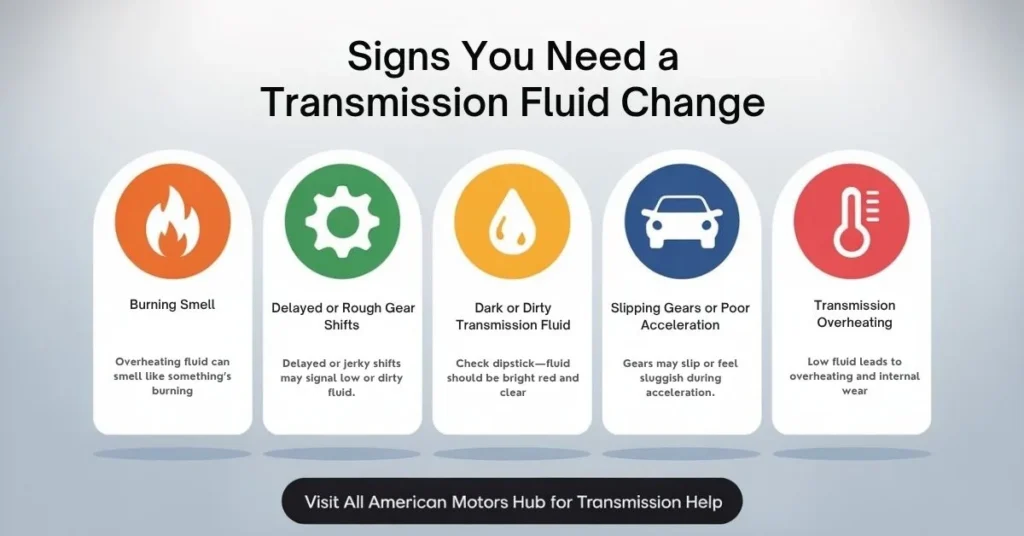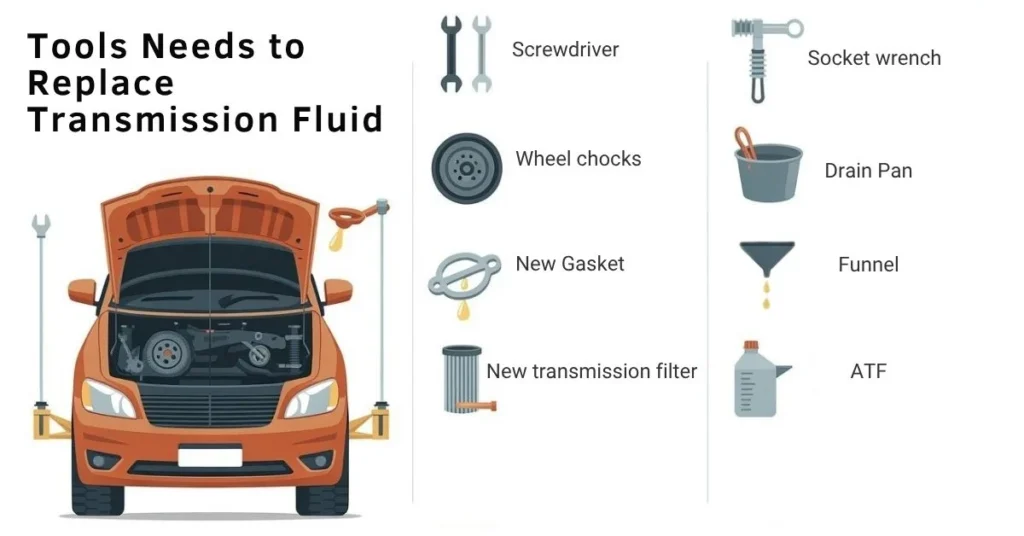Table of Contents
Introduction
When it comes to keeping your vehicle running smoothly, transmission fluid change is one of the most critical yet often overlooked maintenance tasks. Your transmission fluid acts as a lubricant and coolant for the transmission system, helping it shift gears effortlessly while preventing overheating and wear.
Neglecting a changing transmission fluid can lead to serious issues like slipping gears, poor acceleration, or even complete transmission failure. Whether you’re driving a daily commuter or a high-performance vehicle, making sure you change transmission fluid at the right time can extend the life of your transmission and save you from costly repairs down the line.
In this guide, we’ll walk you through everything you need to know about changing transmission fluid, from signs it’s time for a change to a complete DIY step-by-step process. Let’s get started.
What is a Transmission Fluid Change?
A transmission fluid change involves draining the old transmission fluid from a vehicle’s transmission system and replacing it with fresh fluid to maintain optimal performance. The process typically includes removing the transmission pan or drain plug, allowing the old fluid to drain, and refilling with new fluid that meets the vehicle’s specifications. This maintenance, recommended every 30,000–60,000 miles, lubricates gears, reduces friction, and prevents overheating. If you’re noticing rough gear shifts in your Nissan Altima transmission or Toyota Camry transmission, this service is especially critical..
In contrast, a transmission fluid flush uses specialized equipment to force out all old fluid, including from the torque converter and cooler lines, and replace it entirely with new fluid. A flush is more thorough but can dislodge debris in older transmissions, potentially causing issues. A change transmission fluid procedure is less invasive, only replacing fluid in the pan (about 40–60% of total fluid), making it safer for high-mileage vehicles but less comprehensive.
| Feature | Transmission Fluid Change | Transmission Fluid Flush |
| Method | Draining and refilling | Pressurized full system flush |
| Amount of Fluid Replaced | Partial (~40–60%) | Almost 100% |
| Cost | Lower | Higher |
| Tools Needed | Basic tools | Professional equipment |
| Recommended For | Routine maintenance | Heavily contaminated fluid |
Whether you’re planning a fluid change or a flush, always make sure you use a reliable transmission unit. Browse our selection of used Honda transmissions or Chevy automatic transmissions for best results.
Importance of Changing Transmission Fluid
Changing transmission fluid is critical for maintaining a vehicle’s transmission system and ensuring optimal performance. Transmission fluid serves multiple roles: it lubricates gears and moving parts, reduces friction, cools the transmission, and facilitates smooth gear shifts. It also helps transmit power from the engine to the wheels, ensuring efficient operation. Over time, transmission fluid degrades, losing its viscosity and ability to protect components due to heat, contaminants, and wear.
Neglecting a transmission fluid change can lead to serious issues. Degraded fluid may cause overheating, as it fails to dissipate heat effectively, damaging transmission components.This is especially common in models like the Dodge Ram transmission or Jeep Grand Cherokee transmission, where high torque output makes fluid condition critical.It can also result in gear slipping, where the transmission struggles to stay in gear, leading to jerky or delayed shifts. Other risks include increased wear on internal parts, reduced fuel efficiency, and, in severe cases, complete transmission failure, requiring costly repairs. Regular transmission oil change intervals, typically every 30,000–60,000 miles, prevent these problems, extending the transmission’s lifespan and maintaining vehicle reliability.
Signs You Need a Transmission Fluid Change

How to Replace Transmission Fluid – Step-by-Step Guide
If you’re experiencing rough gear shifts or suspect your transmission fluid is old or dirty, it’s time for changing transmission fluid. Here’s a step-by-step DIY guide that walks you through the entire process:

Step 1: Prepare Your Tools and Work Area
Before starting, make sure your vehicle is parked on a flat surface. Gather all necessary tools:
- Car jack and jack stands
- Wheel chocks
- Drain pan
- Socket wrench
- Screwdriver
- New transmission filter and gasket
- Funnel
- Use only manufacturer-recommended ATF. For example, Ford F-150 transmissions require a specific ATF formulation for best results.
- Rags and gloves
Step 2: Safely Lift the Vehicle
Use the jack to raise your car and place it securely on jack stands. Don’t forget to use wheel chocks to prevent the car from rolling. Safety is key.
Step 3: Locate and Remove the Transmission Pan
Put the drain pan beneath the transmission. Using a socket wrench, carefully loosen and remove the bolts around the transmission pan. Fluid will start to drain as you loosen it.
Step 4: Drain the Old Transmission Fluid
Allow the fluid to drain completely into the pan. This step is crucial for a clean transmission fluid change. Be prepared — it can get messy.
Step 5: Remove the Old Filter and Gasket
Once drained, remove the old transmission filter and gasket. These parts often collect debris and should be replaced during every transmission oil change.
Step 6: Install the New Filter and Gasket
Install your new filter and gasket exactly how the old ones were positioned. This ensures a proper seal and clean fluid circulation.
Step 7: Reattach the Transmission Pan
Carefully bolt the transmission pan back into place. Avoid overtightening. Use a torque wrench if available.
Step 8: Add New Transmission Fluid
Use a funnel to slowly pour new automatic transmission fluid into the dipstick tube. Refer to your vehicle’s manual for the correct type and amount.
Not sure what transmission fits your vehicle? Use our VIN Decoder Tool to find the right match instantly
Step 9: Start the Engine and Check Fluid Levels
With the engine running, cycle through all gears and then place the gear in Park. Check the fluid level using the dipstick and add more if necessary.
Step 10: Take a Short Test Drive
Drive for about 10–15 minutes and pay attention to how the vehicle shifts. Recheck the fluid level afterward and top off if needed.
When to Change Transmission Fluid
A transmission fluid change is essential for maintaining a vehicle’s transmission health. Typically, you should change transmission fluid every 30,000 to 60,000 miles, but this interval varies based on driving conditions and vehicle type. Always consult the vehicle’s owner’s manual for manufacturer-specific recommendations, as some modern transmissions, like those in high-performance or heavy-duty vehicles, may require more frequent changes or specialized fluids.
Harsh driving conditions—such as towing, stop-and-go traffic, or extreme temperatures—can accelerate fluid degradation, necessitating earlier changes. Signs like slipping gears, unusual noises, or a burning smell also indicate the need for a fluid change. Regular maintenance within the 30,000–60,000-mile range ensures the transmission remains lubricated, cools effectively, and operates smoothly, preventing costly repairs. Checking the owner’s manual and monitoring driving habits are key to determining the optimal timing for changing transmission fluid.
DIY vs Professional Transmission Fluid Change
Deciding whether to perform changing transmission fluid yourself or hire a professional depends on your skills and resources. How to do transmission fluid change at home involves draining old fluid, replacing the filter (if applicable), and refilling with the correct fluid. DIY saves money but requires tools, a clean workspace, and mechanical knowledge to avoid mistakes like using the wrong fluid or improper sealing, which can harm the transmission. It’s time-consuming and messy, with risks of incomplete fluid replacement.
Hiring a professional ensures expertise, proper equipment, and warranty on work. At All American Motors Hub, our skilled technicians handle changing transmission fluid efficiently, using high-quality fluids and parts. For related needs, explore our used transmissions page. Professionals minimize risks but cost more.
| Option | Pros | Cons |
| DIY | Cost-effective, hands-on control | Time-consuming, requires tools, risk of errors |
| Professional | Expert service, warranty, efficiency | Higher cost, less hands-on involvement |
Conclusion
A regular changing transmission fluid is one of the simplest yet most important maintenance tasks to keep your vehicle running smoothly. It helps your transmission operate efficiently, prevents overheating, and extends the life of internal components.
Neglecting to change transmission fluid can lead to costly repairs and sudden breakdowns, especially if you’re driving in tough conditions or towing heavy loads. Don’t wait until shifting becomes rough or your transmission fails.
Check your owner’s manual, inspect your fluid condition, and if it’s time, either do it yourself or consult a professional. Need help with a failing transmission? Visit All American Motors Hub to explore high-quality used transmissions at competitive prices.
Take action today to protect your vehicle’s performance and your wallet.
Frequently Asked Questions
What is the cost of a transmission fluid change?
The average cost for a transmission fluid change ranges from $80 to $250, depending on the vehicle type and whether it’s done at home or by a professional. Labor costs are a big factor in this range.
Is a transmission fluid flush better than a change?
Not always. A transmission fluid flush replaces nearly all the fluid, while a fluid change only drains part of it. Flushing can be more effective but may stir up debris in older transmissions, so it’s not ideal for every car. Check your manual or ask a technician.
How often should I change my transmission oil?
Experts recommend a transmission oil change every 30,000 to 60,000 miles. However, if you frequently tow or drive in harsh conditions, you may need to change transmission fluid more often.
Can I use any transmission fluid?
No. Always use the manufacturer-recommended automatic transmission fluid (ATF). Using the wrong fluid can lead to slipping, overheating, or internal damage.
How long does a transmission fluid change take?
A standard transmission fluid change usually takes 30 minutes to 1 hour for most vehicles, especially if done by a professional.

